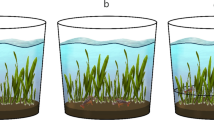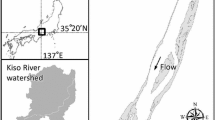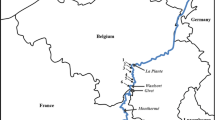Abstract
Conservation of ecosystem engineers, which modulates the surrounding habitat by causing physical state changes in biotic or abiotic materials, is important for maintaining the functional integrity of ecosystems. This study examined the effects of endangered freshwater pearl mussels (Margaritifera laevis and M. togakushiensis) on channel morphology and flow in a low-gradient sandy river. For this, we performed a field removal experiment of mussels using three treatments in twelve 10-m reaches. Mussel abundance and biomass, and three physical variables were measured before, immediately after, and two months to one year after the treatments. Mussel removal resulted in channel degradation with a 60% increase in flow depth, a 30% decrease in current velocity, and a 50% reduction in the width-to-depth ratio two months after the treatments, whereas minimal changes were measured in reaches with mussels. The results indicated that pearl mussels act as an ecosystem engineer affecting the channel morphology and flow of sandy rivers. The conservation of the pearl mussel populations is key to preserving their far-reaching benefits in ecosystem integrity including habitats for other various organisms.




Similar content being viewed by others
Data availability
Data are available from the corresponding author on reasonable request.
References
Akaike, H., 1974. A new look at statistical model identification. IEEE Transactions on Automatic Control 19: 716–723.
Albertson, L. K., & D. C. Allen, 2015. Meta-analysis: Abundance, behavior, and hydraulic energy shape biotic effects on sediment transport in streams. Ecology 96: 1329–1339.
Albertson, L. K., B. J. Cardinale, & L. S. Sklar, 2014. Non-additive increases in sediment stability are generated by macroinvertebrate species interactions in laboratory streams. PLoS ONE 9: e103417.
Albertson, L. K., & M. D. Daniels, 2016. Resilience of aquatic net-spinning caddisfly silk structures to common global stressors. Freshwater Biology 61: 670–679.
Allen, D. C., & C. C. Vaughn, 2011. Density-dependent biodiversity effects on physical habitat modification by freshwater bivalves. Ecology 92: 1013–1019.
Beard, K. H., A. K. Eschtruth, K. A. Vogt, D. J. Vogt, & F. N. Scatena, 2003. The effects of the frog Eleutherodactylus coqui on invertebrates and ecosystem processes at two scales in the Luquillo Experimental Forest, Puerto Rico. Journal of Tropical Ecology 19: 607–617.
Bódis, E., B. Tóth, J. Szekeres, P. Borza, & R. Sousa, 2014. Empty native and invasive bivalve shells as benthic habitat modifiers in a large river. Limnologica . 49: 1–9.
Burnham, K. P., & D. R. Anderson, 2002. Model Selection and Multimodel Inference: A Practical Information-Theoretic Approach. Springer, New York.
Byers, J. E., K. Cuddington, C. G. Jones, T. S. Talley, A. Hastings, J. G. Lambrinos, J. A. Crooks, & W. G. Wilson, 2006. Using ecosystem engineers to restore ecological systems. Trends in Ecology and Evolution 21: 493–500.
Cooper, S. D., S. Diehl, K. Kratz, & O. Sarnelle, 1998. Implications of scale for patterns and processes in freshwater ecology. Australian Journal of Ecology 23: 27–40.
Corenblit, D., A. C. W. Baas, G. Bornette, J. Darrozes, S. Delmotte, R. A. Francis, A. M. Gurnell, F. Julien, R. J. Naiman, & J. Steiger, 2011. Feedbacks between geomorphology and biota controlling Earth surface processes and landforms: A review of foundation concepts and current understandings. Earth-Science Reviews 106: 307–331.
Crain, C. M., & M. D. Bertness, 2006. Ecosystem engineering across environmental gradients: Implications for conservation and management. BioScience 56: 211–218.
Dalbeck, L., J. Janssen, & S. L. Völsgen, 2014. Beavers (Castor fiber) increase habitat availability, heterogeneity and connectivity for common frogs (Rana temporaria). Amphibia Reptilia 35: 321–329.
Dietrich, W. E., & J. T. Perron, 2006. The search for a topographic signature of life. Nature 439: 411–418.
Ferreira-Rodríguez, N., Y. B. Akiyama, O. V. Aksenova, R. Araujo, M. Christopher Barnhart, Y. V. Bespalaya, A. E. Bogan, I. N. Bolotov, P. B. Budha, C. Clavijo, S. J. Clearwater, G. Darrigran, V. T. Do, K. Douda, E. Froufe, C. Gumpinger, L. Henrikson, C. L. Humphrey, N. A. Johnson, O. Klishko, M. W. Klunzinger, S. Kovitvadhi, U. Kovitvadhi, J. Lajtner, M. Lopes-Lima, E. A. Moorkens, S. Nagayama, K.-O. Nagel, M. Nakano, J. N. Negishi, P. Ondina, P. Oulasvirta, V. Prié, N. Riccardi, M. Rudzīte, F. Sheldon, R. Sousa, D. L. Strayer, M. Takeuchi, J. Taskinen, A. Teixeira, J. S. Tiemann, M. Urbańska, S. Varandas, M. V. Vinarski, B. J. Wicklow, T. Zając, & C. C. Vaughn, 2019. Research priorities for freshwater mussel conservation assessment. Biological Conservation 231: 77–87.
Gordon, N. D., T. A. McMahon, B. L. Finlayson, C. J. Gippel, & R. J. Nathan, 2004. Stream Hydrology: An Introduction for Ecologists. John Wiley and Sons, West Sussex, UK.
Grant, G. E., 2012. The geomorphic response of gravel-bed rivers to dams: perspectives and prospects In Church, M., P. M. Biron, & A. G. Roy (eds), Gravel-bed rivers: processes, tools, environments. John Wiley & Sons, Ltd, Oxford, UK: 165–181.
Greathouse, E. A., C. M. Pringle, & W. H. McDowell, 2006. Do small-scale exclosure/enclosure experiments predict the effects of large-scale extirpation of freshwater migratory fauna?. Oecologia 149: 709–717.
Gutiérrez, J. L., C. G. Jones, D. L. Strayer, & O. O. Iribarne, 2003. Mollusks as ecosystem engineers: The role of shell production in aquatic habitats. Oikos 101: 79–90.
Haag, W. R., 2012. North American freshwater mussels: natural history, ecology, and conservation. Cambridge University Press.
Haag, W. R., & J. D. Williams, 2014. Biodiversity on the brink: An assessment of conservation strategies for North American freshwater mussels. Hydrobiologia 735: 45–60.
Hastie, L. C., P. J. Boon, & M. R. Young, 2000. Physical microhabitat requirements of freshwater pearl mussels, Margaritifera margaritifera (L.). Hydrobiologia 429: 59–71.
Hokkaido University, 2007. legislation on animal experimentation of Hokkaido University. https://www.hokudai.ac.jp/jimuk/reiki/reiki_honbun/u010RG00000658.html.
Huusko, A. R. I., L. Greenberg, M. Stickler, T. Linnansaari, M. Nykänen, T. Vehanen, S. Koljonen, P. Louhi, & K. Alfredsen, 2007. Life in the ice lane: the winter ecology of stream salmonids. River Research and Applications 23: 469–491.
Ilarri, M. I., L. Amorim, A. T. Souza, & R. Sousa, 2018. Physical legacy of freshwater bivalves: Effects of habitat complexity on the taxonomical and functional diversity of invertebrates. Science of the Total Environment 634: 1398–1405.
Ilarri, M. I., A. T. Souza, L. Amorim, & R. Sousa, 2019. Decay and persistence of empty bivalve shells in a temperate riverine system. Science of the Total Environment 683: 185–192.
Ishiyama, N., K. Miura, T. Inoue, M. Sueyoshi, & F. Nakamura, 2021. Geology-dependent impacts of forest conversion on stream fish diversity. Conservation Biology 35: 884–896.
Iwata, T., 2007. Linking stream habitats and spider distribution: Spatial variations in trophic transfer across a forest-stream boundary. Ecological Research 22: 619–628.
Johnson, M. F., I. Reid, S. P. Rice, & P. J. Wood, 2009. Stabilization of fine gravels by net-spinning caddisfly larvae. Earth Surface Processes and Landforms 34: 413–423.
Jones, C. G., 2012. Ecosystem engineers and geomorphological signatures in landscapes. Geomorphology 157–158: 75–87.
Jones, C. G., J. H. Lawron, & M. Shachak, 1997. Positive and negative effects of organisms as physical ecosystem engineers. Ecology 78: 1946–1957.
Jones, C. G., J. H. Lawton, & M. Shachak, 1994. Organism as ecosystem engineers. Oikos 69: 373–386.
Kohler, S. L., & M. J. Wiley, 1997. Pathogen outbreaks reveal large-scale effects of competition in stream communities. Ecology 78: 2164–2176.
Kondo, T., & O. Kobayashi, 2005. Revision of the genus Margaritifera (Bivalvia: Margaritiferidae) of Japan, with description of a new species. Venus (Journal of the Malacological Society of Japan) The Malacological Society of Japan 64: 135–140.
Konrad, C. P., 2009. Simulating the recovery of suspended sediment transport and river-bed stability in response to dam removal on the Elwha River, Washington. Ecological Engineering 35: 1104–1115.
Law, A., M. J. Gaywood, K. C. Jones, P. Ramsay, & N. J. Willby, 2017. Using ecosystem engineers as tools in habitat restoration and rewilding: beaver and wetlands. Science of the Total Environment 605–606: 1021–1030.
Law, A., F. Mclean, & N. J. Willby, 2016. Habitat engineering by beaver benefits aquatic biodiversity and ecosystem processes in agricultural streams. Freshwater Biology 61: 486–499.
Lopes-Lima, M., L. E. Burlakova, A. Y. Karatayev, K. Mehler, M. Seddon, & R. Sousa, 2018. Conservation of freshwater bivalves at the global scale: diversity, threats and research needs. Hydrobiologia 810: 1–14.
Lopes-Lima, M., R. Sousa, J. Geist, D. C. Aldridge, R. Araujo, J. Bergengren, Y. Bespalaya, E. Bódis, L. Burlakova, D. Van Damme, K. Douda, E. Froufe, D. Georgiev, C. Gumpinger, A. Karatayev, Ü. Kebapçi, I. Killeen, J. Lajtner, B. M. Larsen, R. Lauceri, A. Legakis, S. Lois, S. Lundberg, E. Moorkens, G. Motte, K. O. Nagel, P. Ondina, A. Outeiro, M. Paunovic, V. Prié, T. von Proschwitz, N. Riccardi, M. Rudzīte, M. Rudzītis, C. Scheder, M. Seddon, H. Şereflişan, V. Simić, S. Sokolova, K. Stoeckl, J. Taskinen, A. Teixeira, F. Thielen, T. Trichkova, S. Varandas, H. Vicentini, K. Zajac, T. Zajac, & S. Zogaris, 2017. Conservation status of freshwater mussels in Europe: state of the art and future challenges. Biological Reviews 92: 572–607.
Lopes-Lima, M., A. Teixeira, E. Froufe, A. Lopes, S. Varandas, & R. Sousa, 2014. Biology and conservation of freshwater bivalves: Past, present and future perspectives. Hydrobiologia 735: 1–13.
Lydeard, C., R. H. Cowie, W. F. Ponder, A. E. Bogan, P. Bouchet, S. A. Clark, K. S. Cummings, T. J. Frest, O. Gargominy, D. G. Herbert, R. Hershler, K. E. Perez, B. Roth, M. Seddon, E. E. Strong, & F. G. Thompson, 2004. The global decline of nonmarine mollusks. BioScience 54: 321–330.
March, J. G., C. M. Pringle, M. J. Townsend, & A. I. Wilson, 2002. Effects of freshwater shrimp assemblages on benthic communities along an altitudinal gradient of a tropical island stream. Freshwater Biology 47: 377–390.
May, C. L., & B. S. Pryor., 2016. Explaining spatial patterns of mussel beds in a Northern California river: The role of flood disturbance and spawning salmon. River Research and Applications 32: 776–785.
Mccaffery, M., & L. Eby, 2016. Beaver activity increases aquatic subsidies to terrestrial consumers. Freshwater Biology 61: 518–532.
Ministry of the Environment of Japan, 2018. Red lists 2018. https://www.env.go.jp/press/files/jp/109278.pdf.
Miura, K., N. Ishiyama, K. Kawajiri, K. Atsumi, Y. Nagasaka, K. Orito, Y. Machida, Y. Gao, H. Nose, J. N. Negishi, & F. Nakamura, 2019a. The co-occurrence of two endangered freshwater pearl mussels (Margaritifera laevis & Margaritifera togakushiensis) within river reaches in Hokkaido, northern Japan. Japanese Journal of Conservation Ecology 24: 39–48.
Miura, K., N. Ishiyama, K. Kawajiri, K. Atsumi, M. Tachibana, Y. Nagasaka, Y. Machida, Y. Gao, J. N. Negishi, I. Koizumi, & F. Nakamura, 2019b. Simple non-lethal identification criteria for two endangered freshwater pearl mussels, Margaritifera laevis and Margaritifera togakushiensis, in Hokkaido, northern Japan. Ecological Research 34: 667–677.
Miura, K., N. Watanabe, & J. N. Negishi, 2017. Leaf litter patches in stream create overwintering habitats for Ezo brown frog (Rana pirica). Limnology 18: 9–16.
Montgomery, D. R., J. M. Buffington, N. P. Peterson, D. Schuett-Hames, & T. P. Quinn, 2011. Stream-bed scour, egg burial depths, and the influence of salmonid spawning on bed surface mobility and embryo survival. Canadian Journal of Fisheries and Aquatic Sciences 53: 1061–1070.
Nilsson, C., F. Lepori, B. Malmqvist, E. Törnlund, N. Hjerdt, J. M. Helfield, D. Palm, J. Östergren, R. Jansson, E. Brännäs, & H. Lundqvist, 2005. Forecasting environmental responses to restoration of rivers used as log floatways: An interdisciplinary challenge. Ecosystems 8: 779–800.
Novais, A., A. T. Souza, M. Ilarri, C. Pascoal, & R. Sousa, 2015. Facilitation in the low intertidal: Effects of an invasive species on the structure of an estuarine macrozoobenthic assemblage. Marine Ecology Progress Series 522: 157–167.
Nowell, R. M., & P. A. Jumars, 1987. Flumes: theoretical and experimental considerations for simulation of benthic environments. Oceanography and Marine Biology Annual Review 25: 91–112.
Peterson, C. H., & R. Black, 1994. An experimentalist’s challenge - When artifacts of intervention interact with treatments. Marine Ecology Progress Series 111: 289–298.
Poff, N. L., J. D. Allan, M. B. Bain, J. R. Karr, K. L. Prestegaard, B. D. Richter, R. E. Sparks, & J. C. Stromberg, 1997. The natural flow regime. BioScience 47: 769–784.
Poff, N. L. R., & J. V. Ward, 1990. Physical habitat template of lotic systems: Recovery in the context of historical pattern of spatiotemporal heterogeneity. Environmental Management 14: 629–645.
R Development Core Team, 2015. R: A Language and Environment for Statistical Computing. Vienna, Austria: R Foundation for Statistical Computing.
Ranvestel, A. W., K. R. Lips, C. M. Pringle, M. R. Whiles, & R. J. Bixby, 2004. Neotropical tadpoles influence stream benthos: Evidence for the ecological consequences of decline in amphibian populations. Freshwater Biology 49: 274–285.
Schindler, D. W., 1998. Replication versus realism: The need for ecosystem-scale experiments. Ecosystems 1: 323–334.
Schneider, C. A., W. S. Rasband, & K. W. Eliceiri, 2012. NIH Image to ImageJ: 25 years of image analysis. Nature Methods 9: 671–675.
Smith, E. P., 2014. BACI Design. Wiley StatsRef: Statistics Reference Online 1–12.
Smokorowski, K. E., & R. G. Randall, 2017. Cautions on using the Before-After-Control-Impact design in environmental effects monitoring programs. Facets 2: 212–232.
Sousa, R., Â. Amorim, E. Froufe, S. Varandas, A. Teixeira, & M. Lopes-Lima, 2015. Conservation status of the freshwater pearl mussel Margaritifera margaritifera in Portugal. Limnologica 50: 4–10.
Sousa, R., A. Ferreira, F. Carvalho, M. Lopes-Lima, S. Varandas, A. Teixeira, & B. Gallardo, 2020. Small hydropower plants as a threat to the endangered pearl mussel Margaritifera margaritifera. Science of the Total Environment 719: 137361.
Sousa, R., J. L. Gutiérrez, & D. C. Aldridge, 2009. Non-indigenous invasive bivalves as ecosystem engineers. Biological Invasions 11: 2367–2385.
Spooner, D. E., & C. C. Vaughn, 2006. Context-dependent effects of freshwater mussels on stream benthic communities. Freshwater Biology 51: 1016–1024.
Statzner, B., 2012. Geomorphological implications of engineering bed sediments by lotic animals. Geomorphology 157–158: 49–65.
Strayer, D. L., 1999. Use of flow refuges by Unionid mussels in rivers. Journal of the North American Benthological Society 18: 468–476.
Tilman, D., 1989. Ecological experimentation: strengths and conceptual problems In Likens, G. E. (ed), Long-term studies in ecology-approaches and alternatives. Springer-Verlag New York, New York: 136–157.
Vaughn, C. C., S. J. Nichols, & D. E. Spooner, 2008. Community and foodweb ecology of freshwater mussels. Journal of the North American Benthological Society 27: 409–423.
Wilby, A., M. Shachak, & B. Boeken, 2001. Integration of ecosystem engineering and trophic effects of herbivores. Oikos 92: 436–444.
Wohl, E., B. P. Bledsoe, R. B. Jacobson, N. L. Poff, S. L. Rathburn, D. M. Walters, & A. C. Wilcox, 2015. The natural sediment regime in rivers: Broadening the foundation for ecosystem management. BioScience 65: 358–371.
Wright, J. P., & C. G. Jones, 2004. Predicting effects of ecosystem engineers on patch‐scale species richness from primary productivity. 85: 2071–2081.
Wright, J. P., C. G. Jones, & A. S. Flecker, 2002. An ecosystem engineer, the beaver, increases species richness at the landscape scale. Oecologia 132: 96–101.
Zimmerman, G. F., & F. A. de Szalay, 2007. Influence of unionid mussels (Mollusca: Unionidae) on sediment stability: an artificial stream study. Limnology/Archiv für Hydrobiologie 168: 299–306.
Acknowledgements
We thank members of the Watershed Conservation and Management Laboratory for field assistance in this study. We also thank Dr. M. Nakaoka and members of the Field Science Center for Northern Biosphere Hokkaido University Akkeshi Marine Station for accommodation. We would like to thank Editage (www.editage.com) for English language editing. We also appreciate the suggestions of the editor, Ronaldo Sousa, and an anonymous reviewer for their review suggestions, which increases the clarity of our manuscript. This study was partly supported by the research fund for the Science Research of Lake Akkeshi and Bekanbeushi Wetland, Grants-in-Aid for Scientific Research (A) (2348021), JSPS Research Fellow Grant Number JP18J12458, JSPS KAKENHI Grant Number JP18K18221, and Environment Research and Technology Development Fund (S15 Predicting and Assessing Natural Capital and Ecosystem Services (PANCES)) of the Environmental Restoration and Conservation Agency, Japan.
Funding
This study was partly supported by the research fund for the Science Research of Lake Akkeshi and Bekanbeushi Wetland, Grants-in-Aid for Scientific Research (A) (2348021), JSPS Research Fellow Grant Number JP18J12458, JSPS KAKENHI Grant Number JP18K18221, and Environment Research and Technology Development Fund (S15 Predicting and Assessing Natural Capital and Ecosystem Services (PANCES)) of the Environmental Restoration and Conservation Agency, Japan.
Author information
Authors and Affiliations
Corresponding author
Ethics declarations
Conflict of interest
The authors declare no conflict of interest, financial or otherwise.
Additional information
Handling editor: Manuel Lopes-Lima
Publisher's Note
Springer Nature remains neutral with regard to jurisdictional claims in published maps and institutional affiliations.
Supplementary Information
Below is the link to the electronic supplementary material.
Rights and permissions
About this article
Cite this article
Miura, K., Watanabe, N., Takagi, Y. et al. The effects of endangered freshwater pearl mussels on channel morphology and flow in a low-gradient sandy river. Hydrobiologia 848, 5119–5134 (2021). https://doi.org/10.1007/s10750-021-04696-6
Received:
Revised:
Accepted:
Published:
Issue Date:
DOI: https://doi.org/10.1007/s10750-021-04696-6




